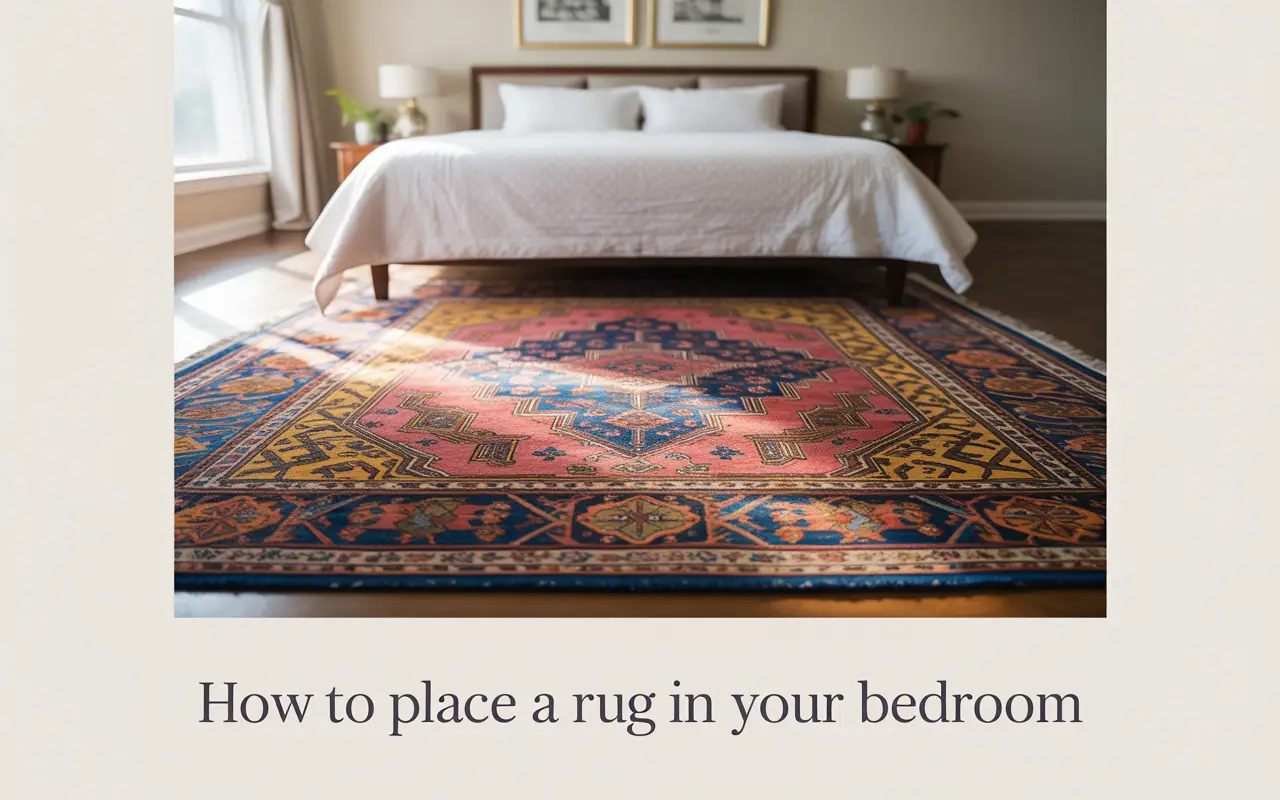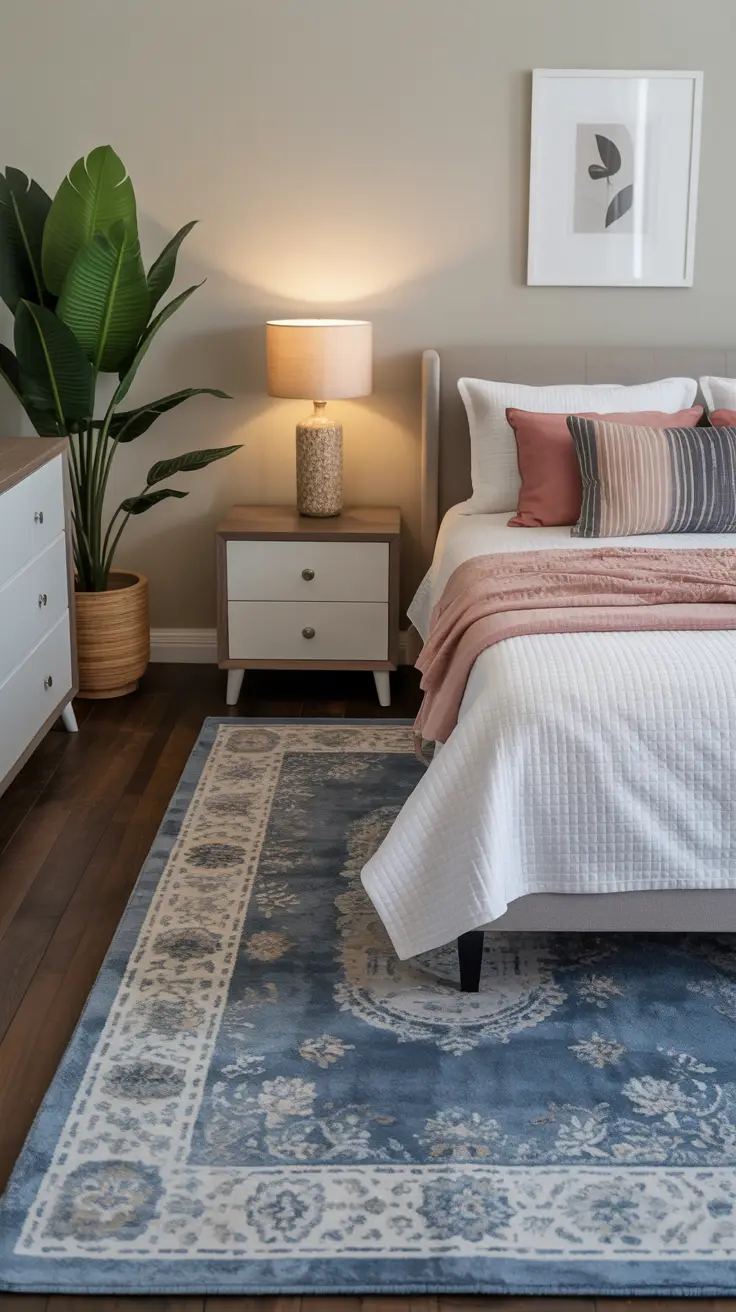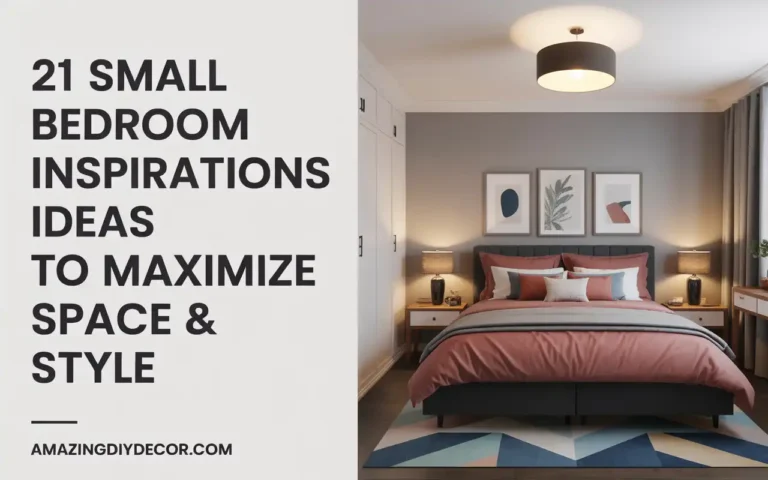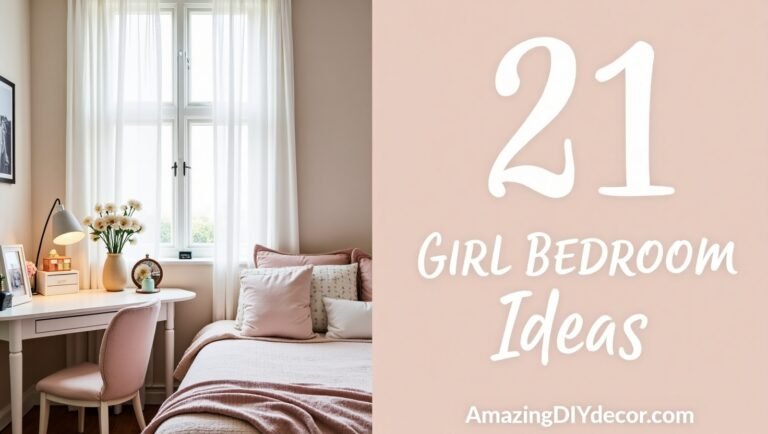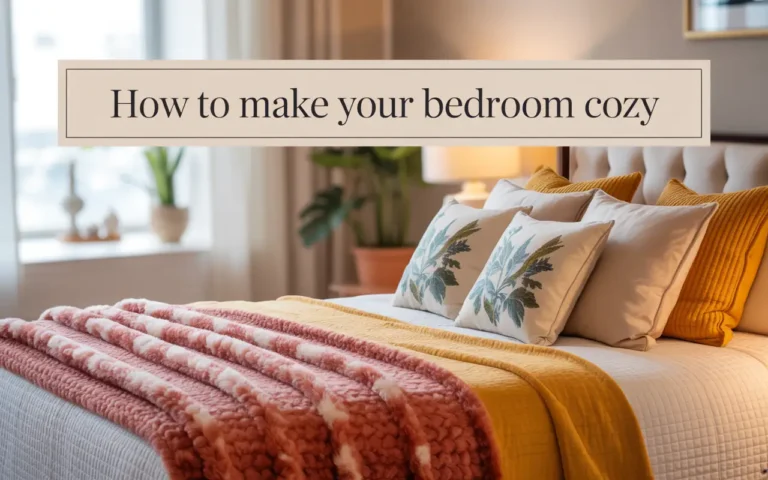How to Place A Rug in Your Bedroom: Layouts, Tips, and Design Ideas
The right rug can transform your bedroom from a simple sleeping space into a warm, inviting sanctuary. But placing that perfect rug? That’s where many homeowners stumble. Too small, and it looks like an afterthought. Too large, and it overwhelms the space. Off-center, and the whole room feels unbalanced.
Whether you’re working with a cozy studio apartment or a spacious master suite, rug placement follows certain principles that can make or break your bedroom’s design. The good news is that once you understand these fundamentals, creating a beautifully styled bedroom becomes much easier.
This comprehensive guide will walk you through everything you need to know about bedroom rug placement. You’ll discover how to choose the right size for your bed, explore different positioning options, and learn professional tricks that interior designers use to create cohesive, comfortable spaces. By the end, you’ll have the confidence to place any rug in any bedroom with style and purpose.
Table of Contents
Start with the Right Rug Size
Choosing the correct rug size forms the foundation of successful bedroom design. The size you select should correspond to both your bed dimensions and the overall room proportions. For a twin bed, a 5×8 foot rug typically works well, providing enough coverage without overwhelming a smaller space. Queen beds pair beautifully with 8×10 foot rugs, which offer generous coverage while maintaining proper scale. King beds demand larger rugs—either 9×12 or 10×14 feet—to create the luxurious, proportioned look these statement pieces deserve.
Room size plays an equally important role in your decision. A large rug in a small bedroom can make the space feel cramped, while a tiny rug in a spacious room appears lost and insignificant. Measure your bedroom carefully, noting the placement of windows, doors, and built-in furniture that might affect rug positioning.
Consider the “18-inch rule” as your starting point: ideally, you want at least 18 inches of rug extending beyond each side of your bed. This creates visual balance and ensures you step onto soft rug rather than cold floor when getting out of bed. However, this rule can be adjusted based on your room’s constraints and personal preferences.
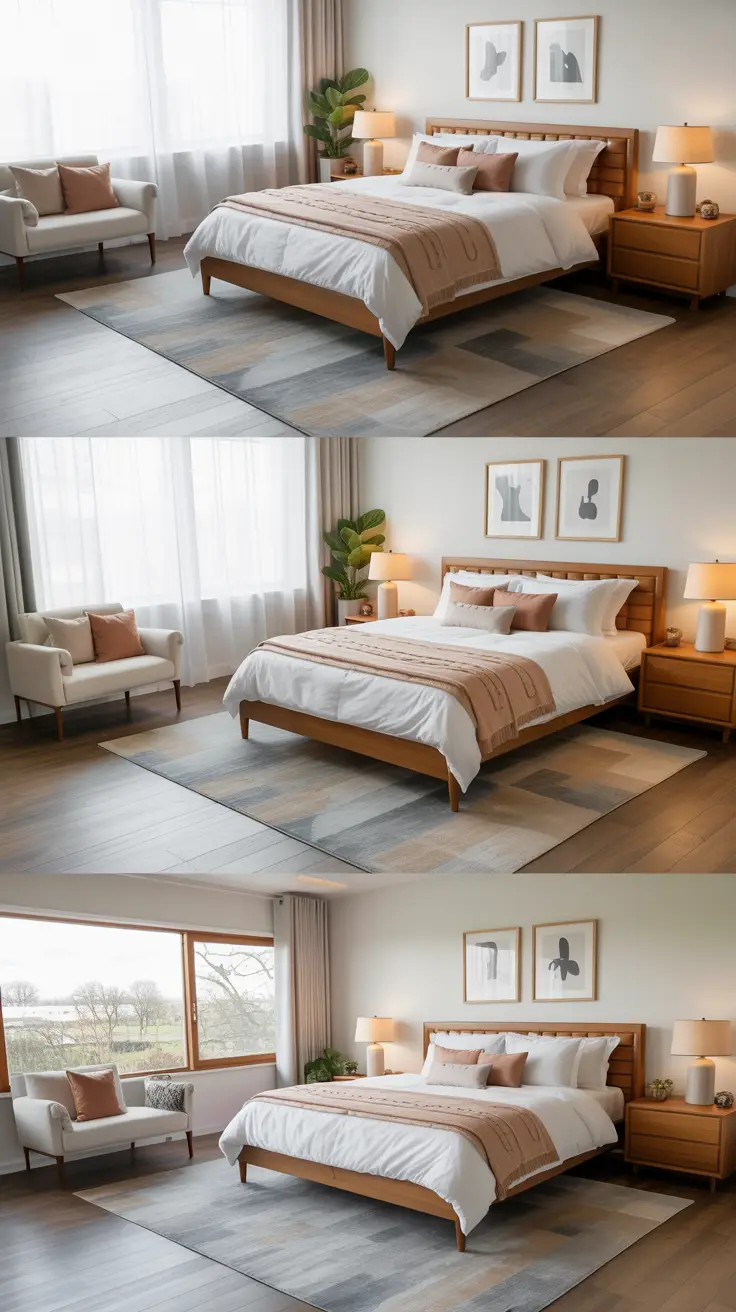
Under the Bed Placement
Positioning your rug partially under the bed creates one of the most popular and versatile bedroom layouts. This approach works exceptionally well because it grounds the bed as the room’s focal point while providing comfort where you need it most—right where your feet touch the floor each morning.
When implementing this placement, aim for the rug to extend 24 to 36 inches beyond the foot of the bed and 18 to 24 inches on each side. This generous overhang ensures that both you and your partner step onto the rug when exiting the bed, regardless of which side you choose. The visual effect creates a cohesive foundation that ties the bed to the floor without overwhelming the space.
This positioning works particularly well in medium-sized bedrooms where you want rug coverage without fully concealing your beautiful hardwood or tile flooring. It also allows you to showcase the rug’s pattern and texture while maintaining clean sight lines around the room’s perimeter. The partial coverage approach offers flexibility for furniture placement, making it easier to position nightstands, benches, or chairs without worrying about rug interference.
Pay attention to the rug’s front edge—it should align roughly with the foot of your bed or extend just slightly beyond it. This creates a clean, intentional look that feels deliberately designed rather than haphazardly placed.
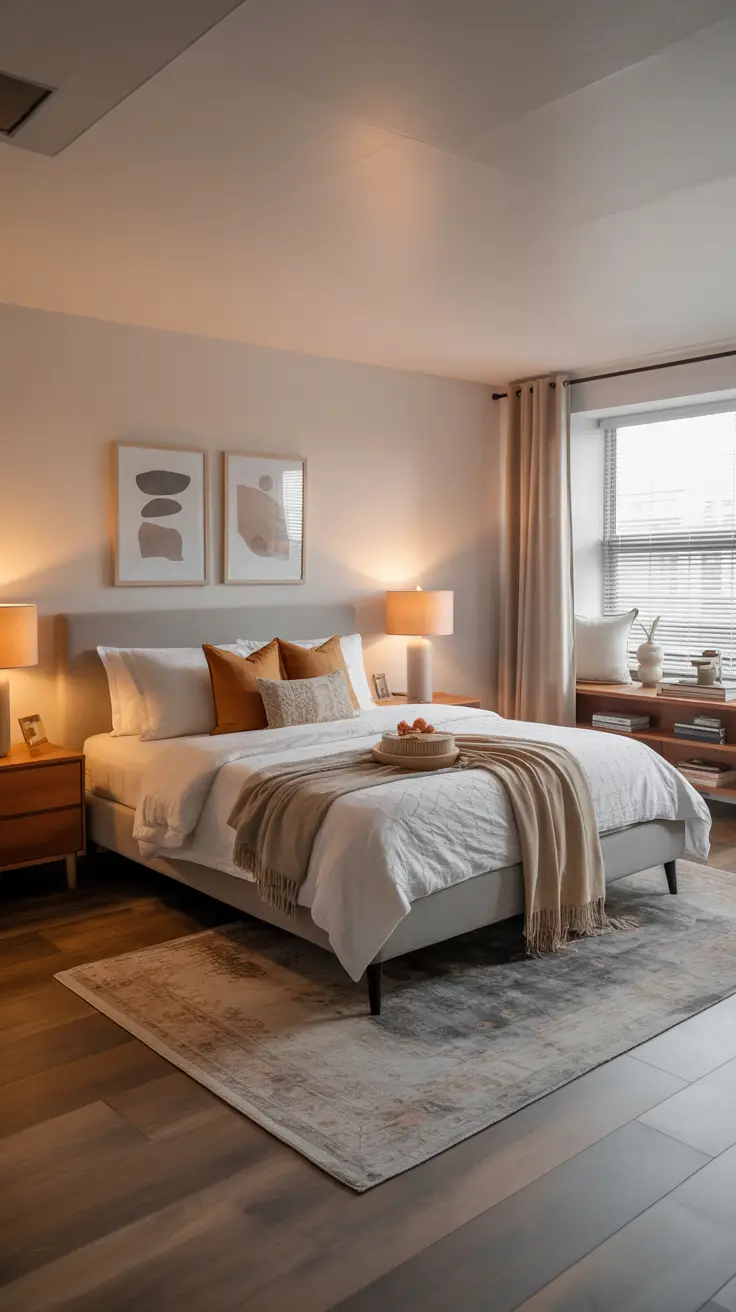
Two-Thirds Under the Bed
The two-thirds placement offers a sophisticated middle ground between minimal and maximum rug coverage. With this approach, you position the rug so that approximately two-thirds of its length slides under the bed, leaving the remaining third visible at the foot. This technique works beautifully with 8×10 or 9×12 rugs in rooms where you want substantial coverage without fully hiding the floor.
This placement creates excellent visual balance by providing generous coverage while maintaining enough exposed flooring to prevent the room from feeling overwhelmed. The visible rug section at the foot of the bed becomes a design feature in itself, offering an opportunity to showcase beautiful patterns, textures, or colors that complement your bedding and decor.
The two-thirds rule particularly shines in bedrooms with interesting flooring that you want to partially display—think gorgeous hardwood, decorative tile, or polished concrete. It also works well when you have a bedroom bench or storage chest at the foot of the bed, as the visible rug portion can help define and anchor this additional furniture piece.
When implementing this placement, ensure the rug extends equally on both sides of the bed to maintain symmetry. The goal is creating a deliberate, balanced look that feels both generous and restrained. This approach also makes the room easier to vacuum and maintain, as you have clear access to both the exposed floor and the visible rug portion.
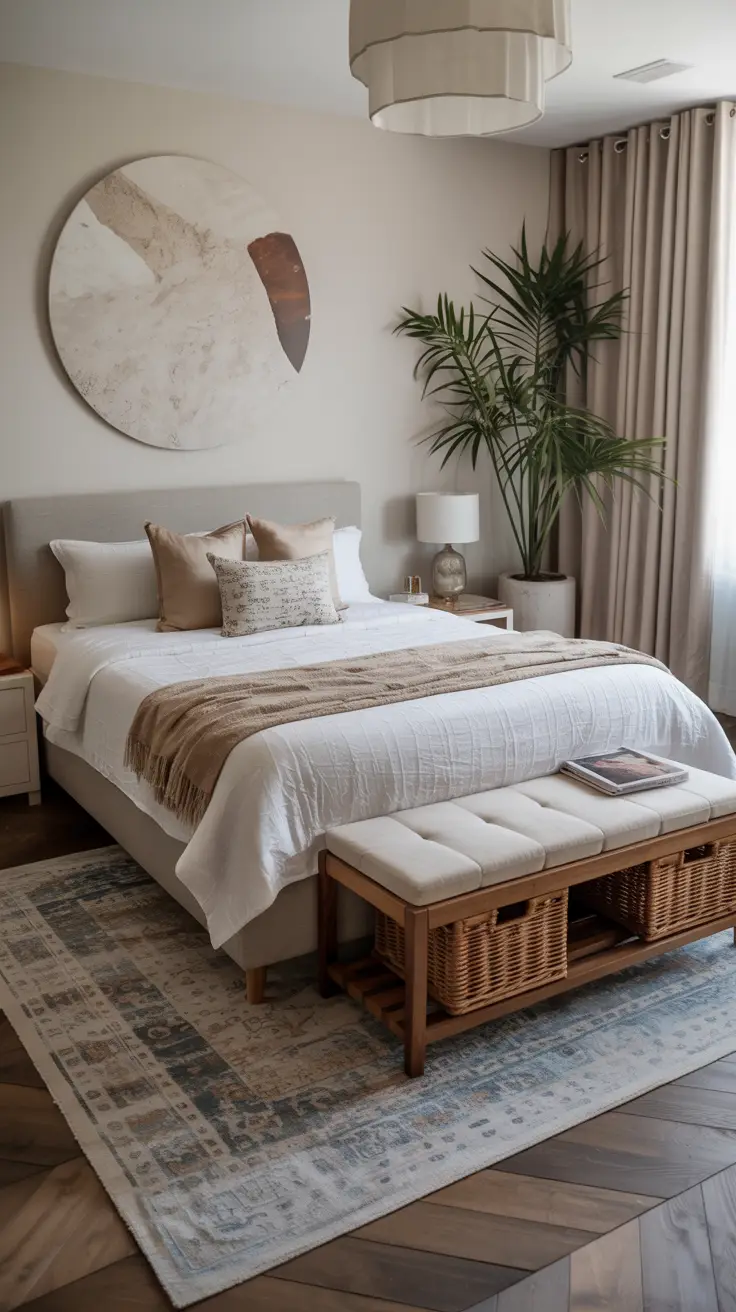
Fully Under the Bed
Placing a large rug completely under your bed creates the most luxurious and enveloping bedroom experience. This approach works best with oversized rugs—typically 10×14 feet or larger—that can accommodate the full bed footprint while extending generously on all sides. The result is a seamless, hotel-like aesthetic that makes your bedroom feel like a high-end retreat.
When executed properly, full coverage creates unparalleled comfort and warmth underfoot. Every step around your bed lands on soft, cushioned surface rather than cold, hard flooring. This placement particularly benefits bedrooms with tile, concrete, or other hard surfaces that can feel unwelcoming in the early morning hours.
The visual impact of full coverage cannot be overstated. It creates a cohesive foundation that unifies the entire sleeping area while adding significant warmth and texture to the space. Large rugs also help absorb sound, making your bedroom quieter and more peaceful—especially valuable in apartments or multi-story homes where noise transfer concerns exist.
However, full coverage requires careful planning and investment. You’ll need a substantially sized rug, which typically costs more than smaller alternatives. You’ll also need adequate floor space to make this approach work without the rug extending into doorways or conflicting with other furniture pieces. Measure carefully and consider the room’s traffic patterns before committing to this luxurious but space-intensive option.
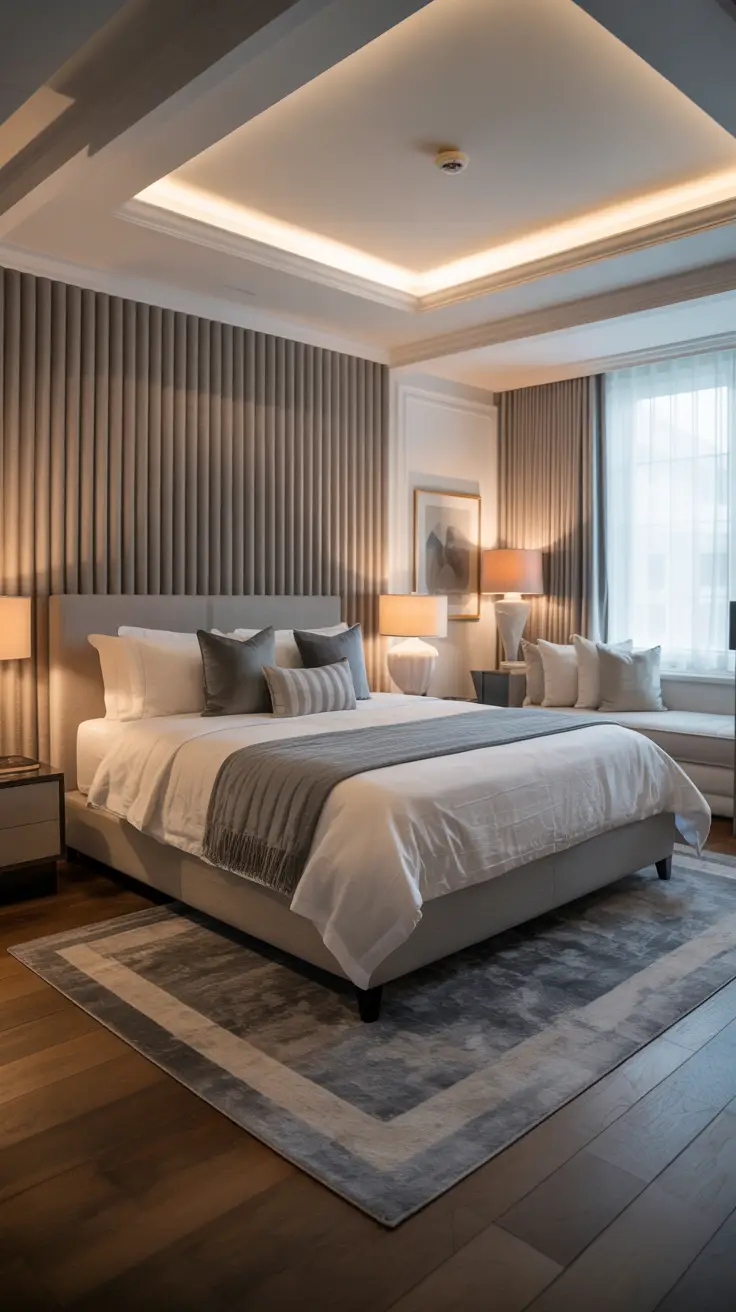
At the Foot of the Bed
Positioning a rug solely at the foot of the bed offers a practical and stylish solution for smaller spaces or budget-conscious decorating. This approach typically uses a 3×5 or 4×6 foot rug placed perpendicular to the bed, creating a defined landing spot that adds color, texture, and comfort without overwhelming the room.
This placement works exceptionally well in guest bedrooms, children’s rooms, or any space where you want rug benefits without major floor coverage. The foot-of-bed position provides cushioning exactly where many people step when getting out of bed, while the smaller size makes it easier to clean and rearrange when needed.
From a design perspective, a foot-of-bed rug serves as an excellent opportunity to introduce bold patterns, vibrant colors, or interesting textures that might feel overwhelming in a larger format. You can experiment with geometric designs, animal prints, or bright hues that add personality without dominating the entire room’s color scheme.
This approach also pairs beautifully with bedroom benches, storage ottomans, or decorative chests placed at the foot of the bed. The rug helps anchor these furniture pieces while creating a cohesive vignette that feels intentionally designed. Choose a rug that complements both your bedding and any furniture it will interact with to create a harmonious, pulled-together look that enhances rather than competes with your bedroom’s overall aesthetic.
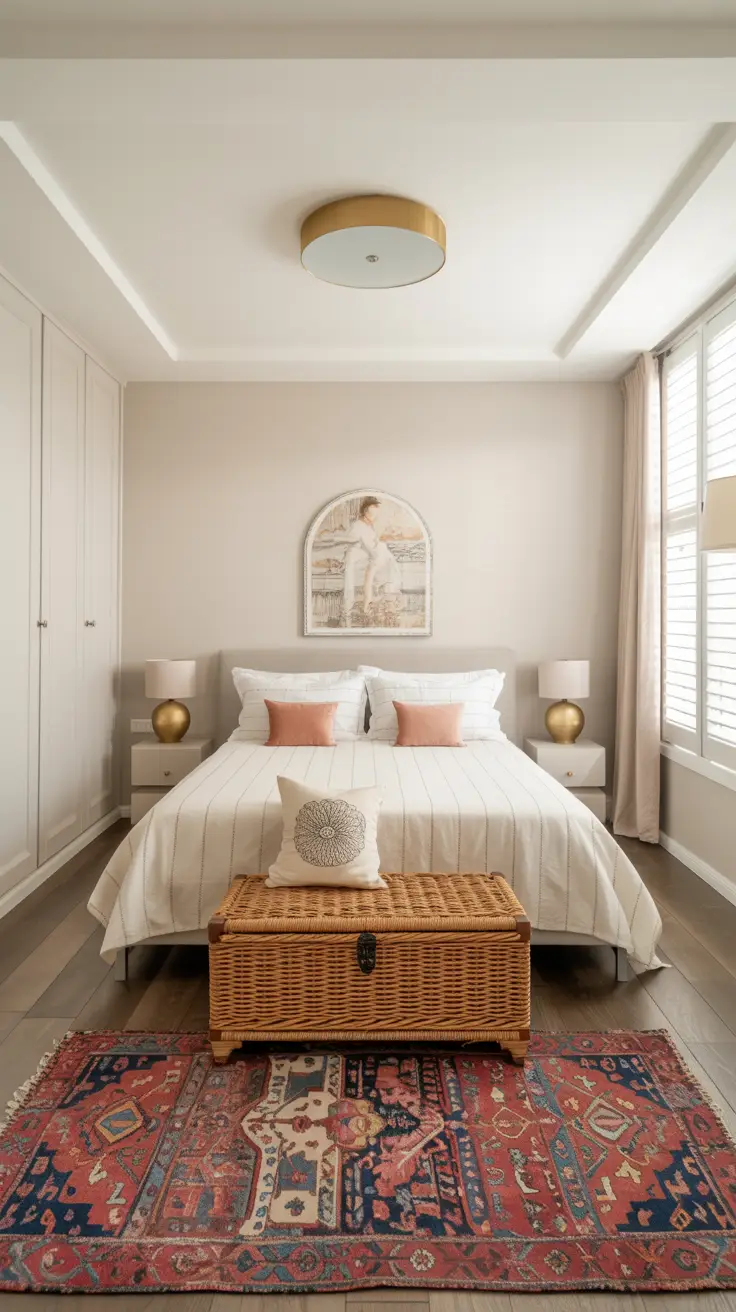
Runners on Each Side of the Bed
Using two matching runners alongside your bed creates an elegant, symmetrical solution that works particularly well in narrower bedrooms or spaces where traditional rug sizes feel overwhelming. This approach typically employs 2.5×8 or 3×10 foot runners positioned parallel to the bed, providing comfort and style exactly where you need it most.
Runner placement offers practical benefits that larger rugs cannot match. You get soft landing spots for both sides of the bed without the expense or space requirements of a room-sized rug. This approach also works beautifully in bedrooms with interesting flooring that you want to showcase—the runners provide comfort and design interest while allowing the majority of your beautiful floors to remain visible.
The symmetrical nature of dual runners creates a sophisticated, hotel-inspired aesthetic that feels both luxurious and intentional. This placement works especially well in master bedrooms where both partners want equal comfort and convenience. The visual balance created by matching runners helps frame the bed while maintaining clean, uncluttered sight lines throughout the rest of the room.
When selecting runners, ensure they’re identical in size, pattern, and color for the most polished look. Position them so they extend slightly beyond the head and foot of the bed, creating generous coverage without interfering with nightstands, lamps, or other bedside furniture. This approach also makes room maintenance easier, as you can clean or rearrange one runner without disturbing the entire bedroom layout.
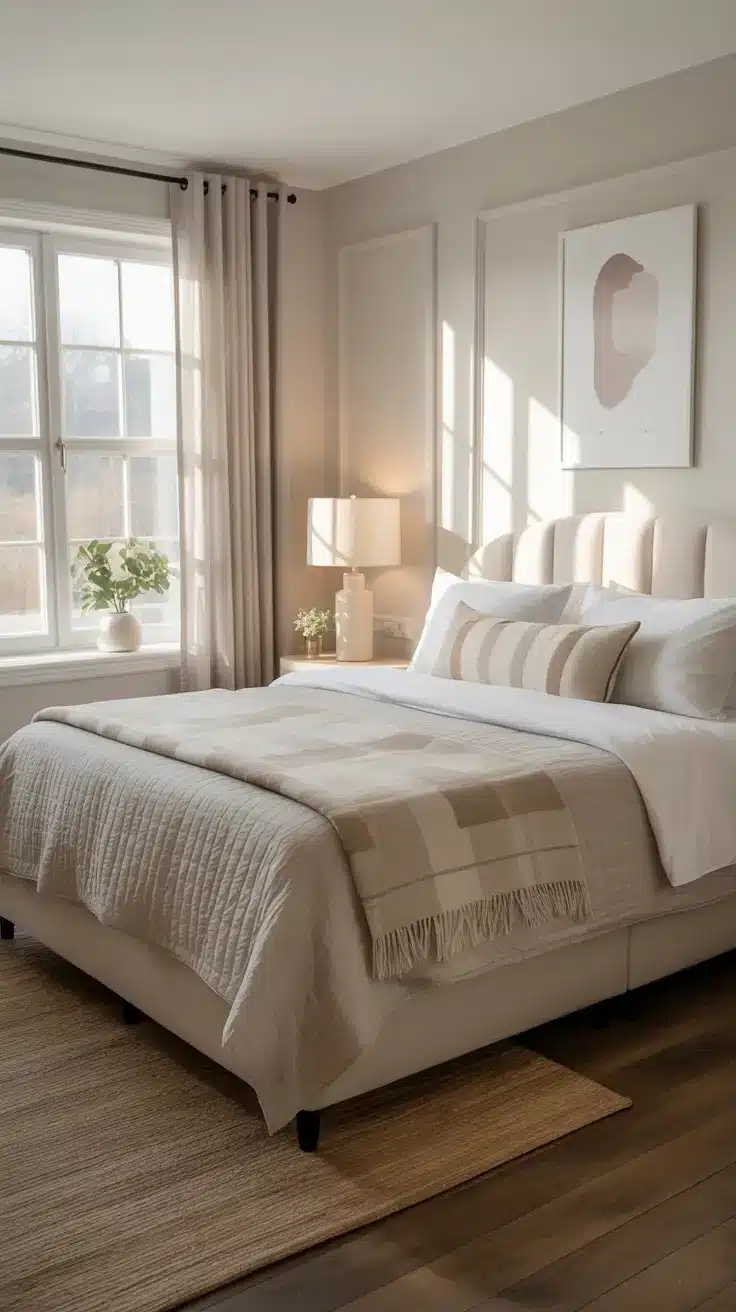
Layering Rugs for Texture
Layering multiple rugs creates visual depth and textural interest that single rugs cannot achieve. This sophisticated technique typically involves placing a larger, neutral base rug under the bed, then adding smaller, patterned or textured rugs on top to create zones of interest and comfort. The layered approach allows you to experiment with different colors, patterns, and textures while maintaining overall cohesion.
Start with a substantial base rug—usually in neutral tones like beige, gray, or cream—that provides foundational coverage. This bottom layer should be large enough to extend properly around your bed while serving as a calming backdrop for more dynamic top layers. Then add smaller rugs with interesting patterns, bold colors, or luxurious textures like sheepskin or silk to create focal points and additional comfort zones.
This technique works particularly well in eclectic or bohemian bedroom styles where mixing patterns and textures feels natural and intentional. You might layer a vintage Persian runner over a natural jute rug, or place a faux fur accent rug over a neutral wool base. The key is choosing pieces that complement rather than compete with each other.
Layering also offers practical advantages—you can easily change the room’s look by swapping out top layers while keeping the expensive base rug in place. This flexibility makes layering an excellent choice for renters or anyone who enjoys refreshing their decor seasonally. Ensure each layer lies flat and secure to prevent tripping hazards or premature wear from shifting and bunching.
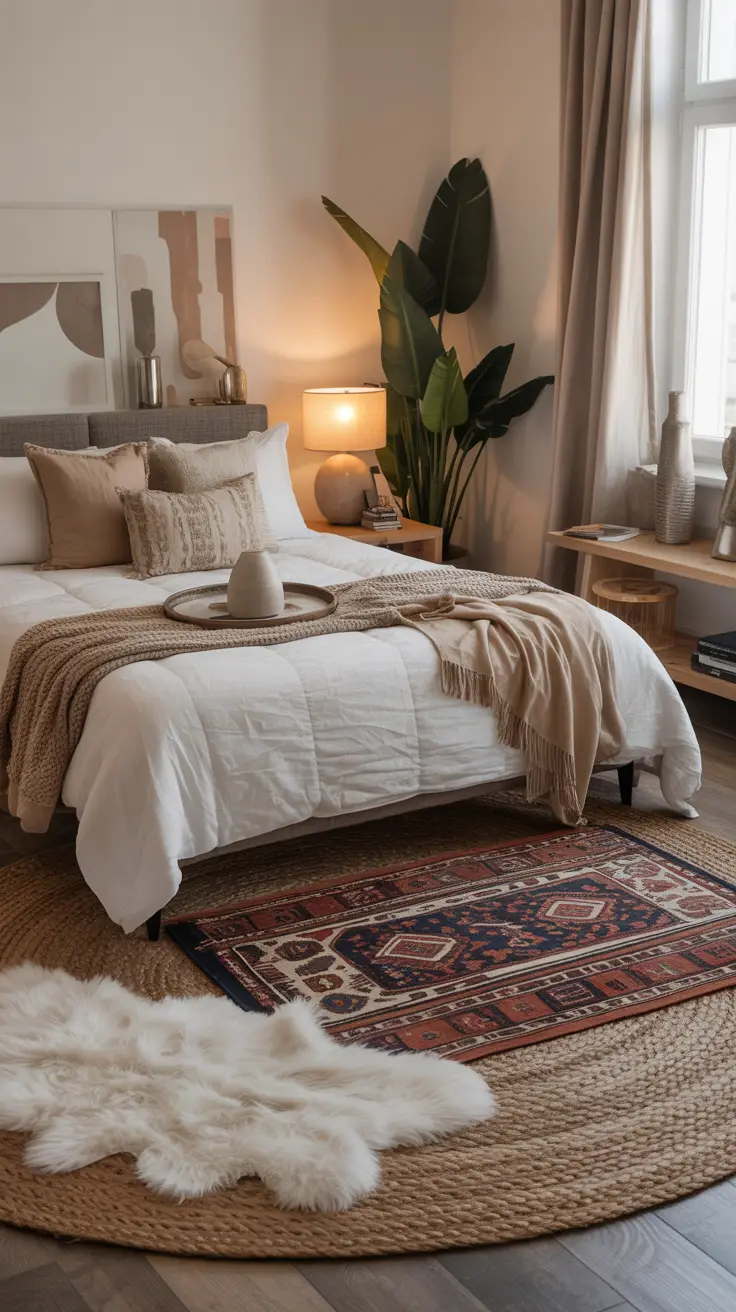
Centering a Rug in a Small Bedroom
In compact bedrooms, centering a moderately sized rug can create the illusion of more space while adding essential warmth and comfort. This technique works best with 5×8 or 6×9 foot rugs positioned in the room’s center, leaving visible flooring around all edges. The exposed floor borders help the room feel larger and less cluttered than wall-to-wall coverage would achieve.
When centering a rug in a small bedroom, aim for consistent borders around all edges—typically 18 to 24 inches of exposed flooring. This creates visual breathing room that makes compact spaces feel more open and airy. The rug should be large enough to anchor the bed while small enough to avoid crowding doorways, closets, or other essential areas.
Consider the room’s traffic patterns when centering your rug. The placement should feel natural and logical rather than forced or awkward. If your bed sits against one wall, you might center the rug between the bed and the opposite wall rather than in the room’s exact geometric center. The goal is creating balance and flow that makes the space feel comfortable and well-proportioned.
This approach works particularly well when you want to highlight beautiful flooring—whether that’s original hardwood, decorative tile, or polished concrete. The centered rug provides necessary comfort and style while allowing your floors to contribute significantly to the room’s overall aesthetic. Choose rug colors and patterns that complement rather than compete with your flooring for the most harmonious result.
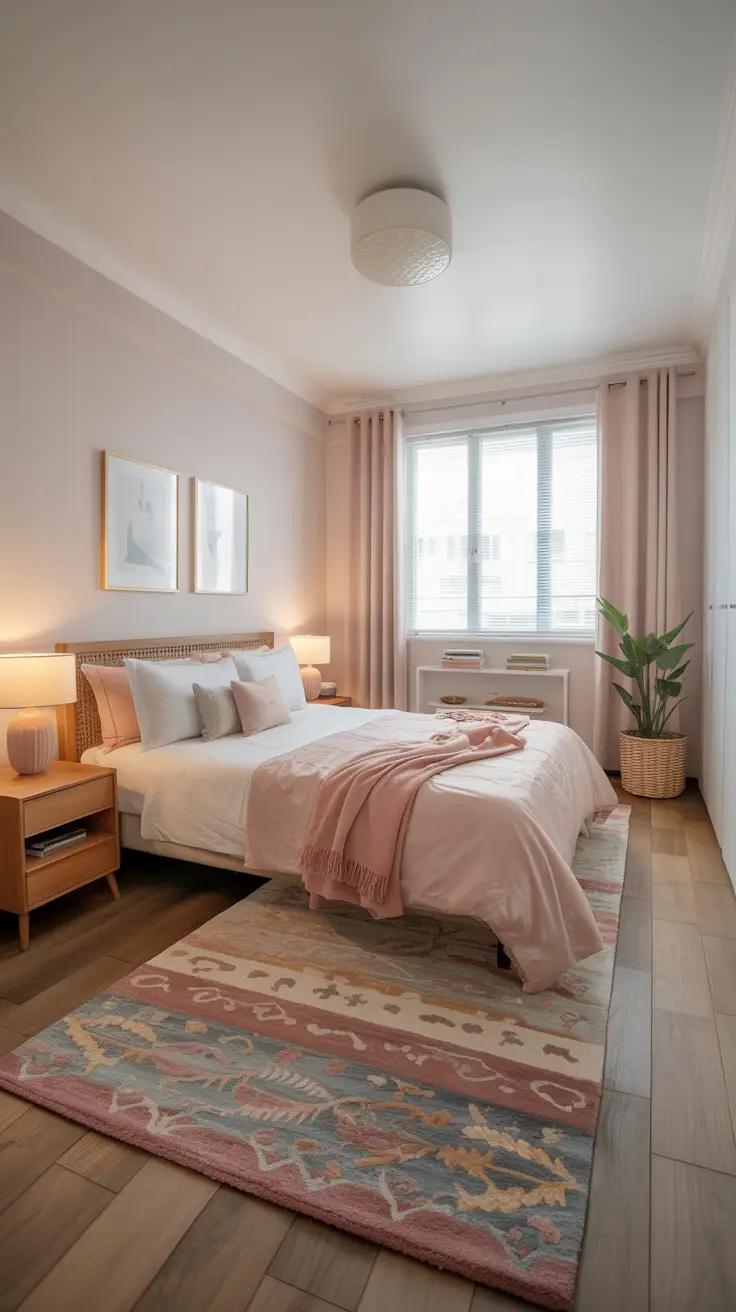
Rug Placement in a Bedroom with Furniture
Integrating a rug seamlessly with existing bedroom furniture requires careful planning and attention to proportions. The rug should enhance rather than compete with pieces like dressers, nightstands, benches, or seating areas. The key is achieving balance—ensuring the rug feels connected to your furniture arrangement without creating awkward gaps or uncomfortable overlaps.
When working around nightstands, decide whether you want the rug to extend underneath them or stop just short. Both approaches can work, but consistency is crucial—if the rug goes under one nightstand, it should go under the other for visual balance. The same principle applies to bedroom benches or chairs—they should either sit fully on the rug, fully off it, or consistently positioned with just their front legs touching the rug’s edge.
Consider furniture height and visual weight when making these decisions. Heavy, dark pieces might look better sitting partially on a rug to help ground them visually, while lighter, more delicate furniture can often sit adjacent to the rug without appearing disconnected. The goal is creating a cohesive arrangement where every piece feels intentionally placed rather than randomly scattered.
Pay special attention to dresser placement—these large pieces can easily overwhelm a rug if not properly considered. If your dresser sits against the same wall as your bed, the rug typically should not extend underneath it unless you’re using a very large rug that can accommodate both pieces generously. Instead, let the rug define the sleeping area while allowing the dresser to sit on exposed flooring with its own visual space.
Also Read:
Also Read:
How To Decorate a Small Bedroom
How To Decorate A Bedroom
Rug Shapes and Their Effects
The shape of your bedroom rug significantly impacts both the room’s visual flow and its overall aesthetic appeal. Rectangular rugs offer the most traditional and versatile option, working well with standard bed sizes and room layouts. Their clean lines complement most bedroom furniture while providing practical coverage that aligns naturally with bed dimensions and room proportions.
Round rugs create an entirely different energy in bedroom spaces. They soften hard edges and rigid furniture lines while adding unexpected visual interest that can make a room feel more dynamic and welcoming. Round rugs work particularly well in square bedrooms or spaces with lots of angular furniture, where their curved lines provide pleasing contrast. However, they require more careful sizing—too small, and they appear insignificant; too large, and they can overwhelm the space or create awkward furniture relationships.
Irregular or uniquely shaped rugs—like cowhides, sheepskins, or artistic contemporary pieces—serve as statement elements that can define your bedroom’s personality. These pieces work best when treated as focal points rather than foundational elements. They might sit at the foot of the bed, beside a reading chair, or in a corner seating area where their distinctive shape can be fully appreciated.
Consider your room’s architectural features when choosing rug shapes. Rectangular rugs emphasize linear elements like windows, doorways, and built-in furniture, while round rugs can help balance or soften these features. The shape you choose should complement your bedroom’s natural lines and proportions rather than fighting against them.
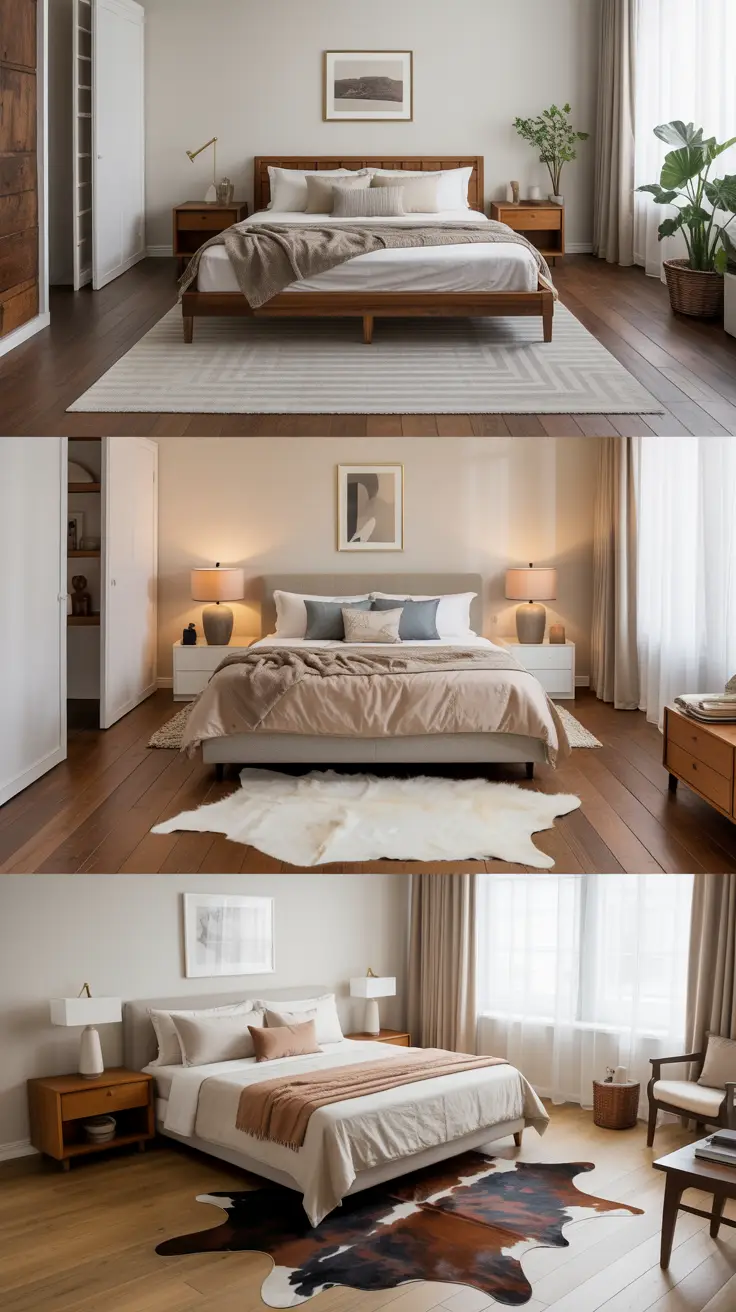
Color and Pattern Considerations
Selecting the right colors and patterns for your bedroom rug requires balancing multiple design elements while considering the room’s overall mood and function. Your rug should complement your existing bedding, wall colors, and furniture while either harmonizing with the current palette or providing intentional contrast that enhances the space’s visual interest.
Neutral rugs in shades of beige, gray, cream, or soft brown offer maximum versatility and longevity. These colors work with virtually any bedding combination and won’t compete with artwork, pillows, or other decorative accessories you might want to change seasonally. Neutral rugs also tend to show dirt and wear less obviously, making them practical choices for high-traffic bedrooms or spaces with pets.
Bold colors and dramatic patterns can transform a bedroom’s entire personality, but they require more careful consideration. A vibrant rug might serve as the room’s focal point, with other elements chosen to complement its dominant hues. Alternatively, a patterned rug can tie together multiple colors already present in the space, creating cohesion between disparate elements like artwork, curtains, and accent pillows.
Consider the psychological impact of your color choices—cool blues and greens promote relaxation and sleep, while warm reds and oranges create energy and coziness. Patterns also influence mood: geometric designs feel contemporary and structured, while florals or organic patterns create softer, more romantic atmospheres. Choose colors and patterns that align with how you want to feel in your bedroom sanctuary.
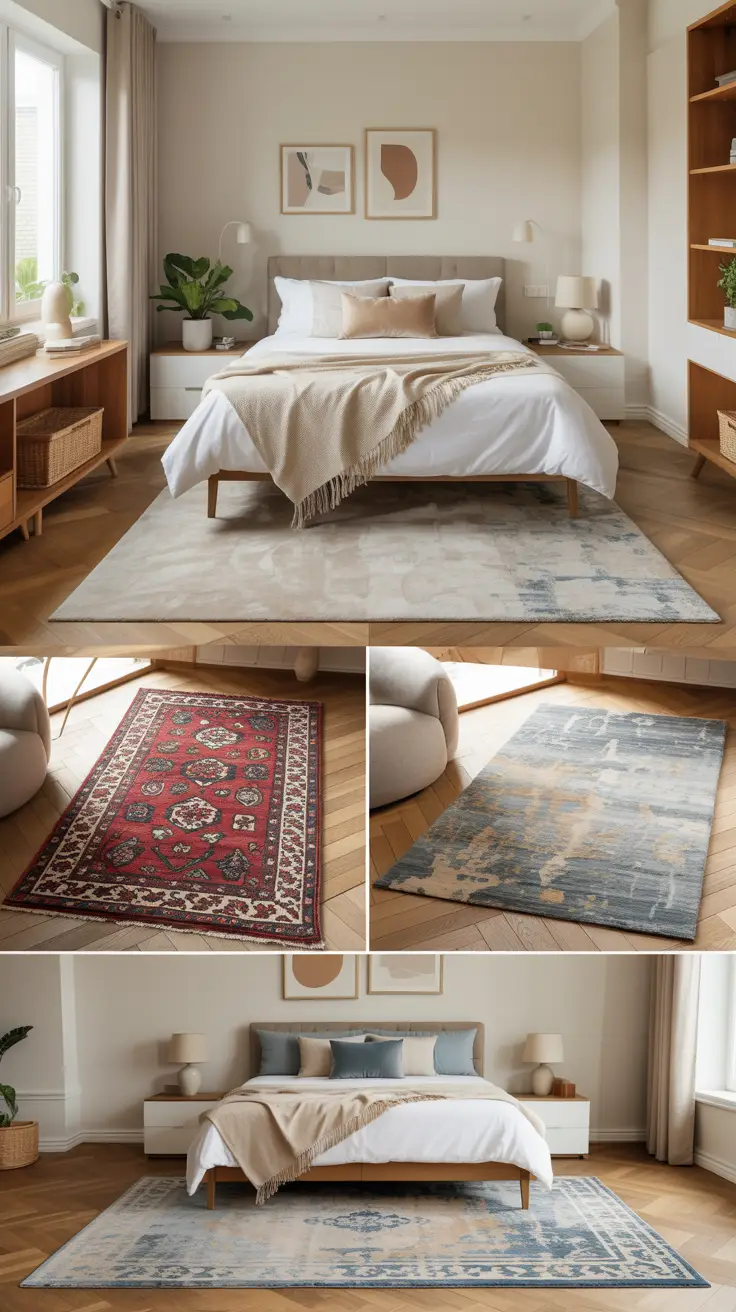
How to Anchor a Rug for Safety
Properly securing your bedroom rug prevents dangerous slipping while extending its lifespan and maintaining its appearance. Even the most beautifully placed rug becomes problematic if it shifts, bunches, or creates tripping hazards. Investing in appropriate rug anchoring solutions protects both your safety and your decorating investment.
Rug pads represent the most effective anchoring solution for most bedroom applications. Choose pads specifically designed for your flooring type—rubber-backed pads work well on hardwood, while waffle-weave pads suit carpeted floors. The pad should be slightly smaller than your rug (about two inches shorter on each side) to remain invisible while providing maximum grip and cushioning.
For smaller rugs or temporary solutions, double-sided carpet tape offers an alternative anchoring method. Apply tape strips along the rug’s perimeter, ensuring the adhesive bonds securely with both the rug backing and the floor surface. This approach works particularly well for thin rugs or spaces where rug pads feel too bulky.
Consider the long-term benefits of proper rug anchoring beyond immediate safety concerns. Secured rugs wear more evenly, maintain their shape better, and require less frequent adjustment and cleaning. The investment in quality anchoring pays dividends through extended rug life and reduced maintenance headaches. Additionally, properly anchored rugs feel more luxurious underfoot, as they don’t shift or bunch when walked upon.
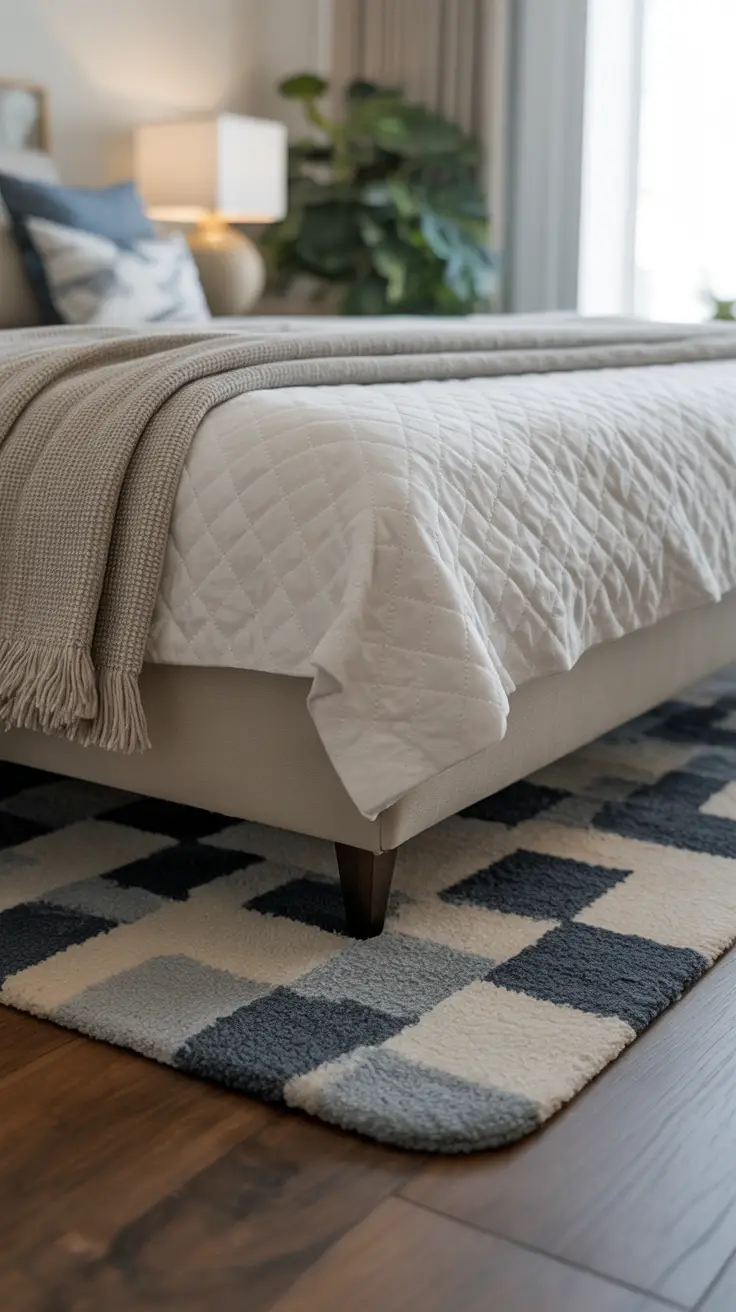
Rug Placement in Shared or Studio Bedrooms
In multipurpose spaces where bedrooms serve multiple functions, strategic rug placement helps define distinct zones while maintaining overall cohesion. Studio apartments, shared bedrooms, or master suites with sitting areas benefit from rugs that create visual boundaries between sleeping, working, dressing, and relaxing areas.
Use rugs to establish the sleeping zone’s boundaries in open-plan spaces. A substantial rug under and around the bed clearly defines this area as private and restful, even when it shares space with desks, dining areas, or entertainment centers. The rug creates psychological separation that helps your brain associate the space with sleep and relaxation rather than work or social activities.
In shared bedrooms, individual rugs can help define personal territories while maintaining overall design harmony. Matching or complementary rugs beside each bed create equity and privacy without requiring physical barriers. Alternatively, a large shared rug can unify the space while smaller accent rugs near each bed provide individual comfort and style expression.
Consider traffic flow when placing rugs in multipurpose spaces. The rug should enhance rather than impede movement between different functional areas. Avoid placing rugs where they might create obstacles or force awkward navigation around furniture. The goal is supporting the room’s various functions while creating clear, logical pathways between different activity zones.
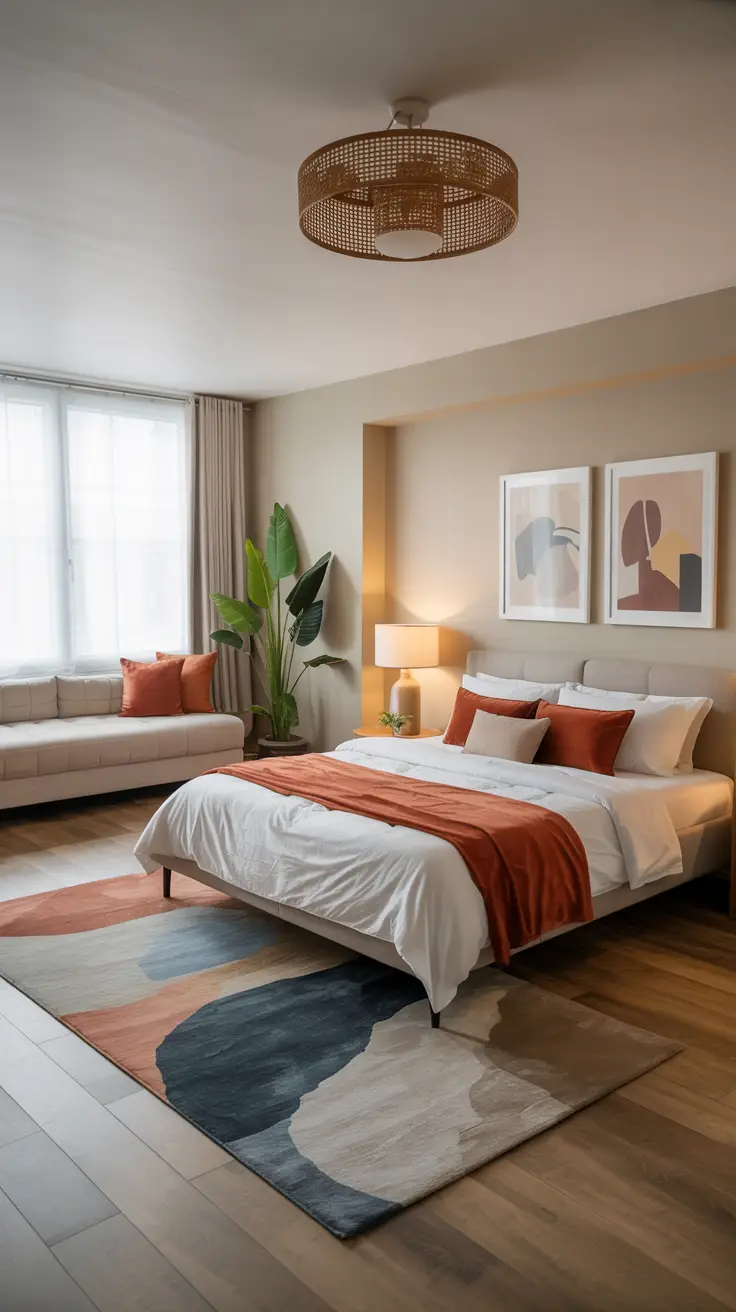
Common Rug Placement Mistakes to Avoid
Understanding frequent rug placement errors helps you avoid costly mistakes and achieve professional-looking results from the start. The most common mistake involves choosing rugs that are too small for the space and furniture they’re meant to serve. A tiny rug beside a large bed looks insignificant and fails to provide the grounding effect that proper rug placement should achieve.
Off-center placement ranks as another frequent error that immediately signals amateur decorating. When rugs sit askew relative to the bed or room’s architecture, the entire space feels unbalanced and uncomfortable. Take time to measure and mark proper placement before committing to a final position—rushing this step often leads to disappointing results that require repositioning.
Ignoring door clearance creates both practical and aesthetic problems. Rugs that interfere with door opening and closing become daily annoyances, while those that extend awkwardly into doorways create visual disruption and potential tripping hazards. Always account for door swings and traffic patterns when sizing and positioning bedroom rugs.
Failing to consider furniture leg placement represents another common oversight. When only some furniture legs rest on the rug while others sit on bare floor, the arrangement looks haphazard and unfinished. Develop a consistent approach—whether furniture sits entirely on, entirely off, or partially on the rug—and apply it throughout the room for cohesive results that feel deliberately designed rather than accidentally arranged.
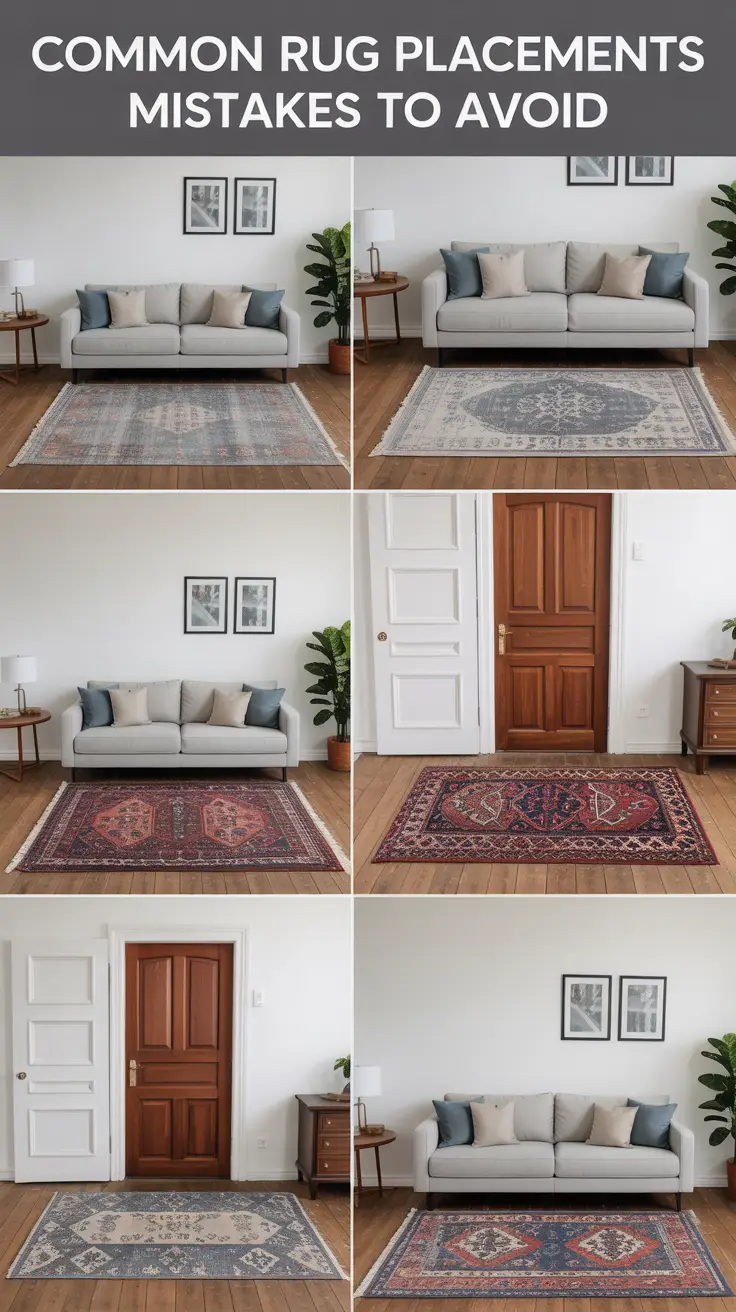
Final Touches: Styling Around the Rug
Once your rug is perfectly positioned, thoughtful styling helps integrate it seamlessly into your bedroom’s overall design scheme. The rug should feel like an integral part of the room rather than an afterthought, which requires coordinating other elements to complement its color, texture, and scale.
Echo the rug’s colors in other bedroom textiles for cohesive sophistication. If your rug features blue accents, incorporate similar blues in throw pillows, artwork, or window treatments. This repetition creates visual flow that ties the room together while preventing the rug from feeling isolated or disconnected from the broader design scheme.
Consider texture relationships when styling around your rug. A plush, high-pile rug might pair beautifully with smooth silk curtains and crisp cotton bedding, creating interesting contrast through varied surface textures. Alternatively, a flat-weave rug could complement nubby linen pillows and wool throws for a more uniform, cozy feel that emphasizes comfort over contrast.
Pay attention to scale relationships between your rug and other decorative elements. Large, bold rug patterns work well with simpler bedding and artwork, while busy bedspreads pair better with solid or subtly patterned rugs. The goal is achieving balance where each element enhances the others without creating visual competition or overwhelming the space with too many competing focal points.
Creating Your Perfect Bedroom Sanctuary
Mastering bedroom rug placement transforms your sleeping space from functional to fabulous. The techniques covered in this guide provide the foundation for creating a bedroom that feels both comfortable and beautifully designed, regardless of your space’s size or budget constraints.
Remember that the best rug placement serves both practical and aesthetic purposes—it should feel good underfoot while enhancing your room’s visual appeal. Take time to consider your specific needs, measure carefully, and don’t rush the decision process. A well-placed rug becomes a long-term investment in your daily comfort and your home’s overall appeal.
Start by assessing your current bedroom setup and identifying which placement approach best suits your space, lifestyle, and design preferences. Whether you choose full coverage luxury or strategic accent placement, the principles outlined here will help you achieve professional-looking results that make your bedroom feel like the restful sanctuary it should be.
